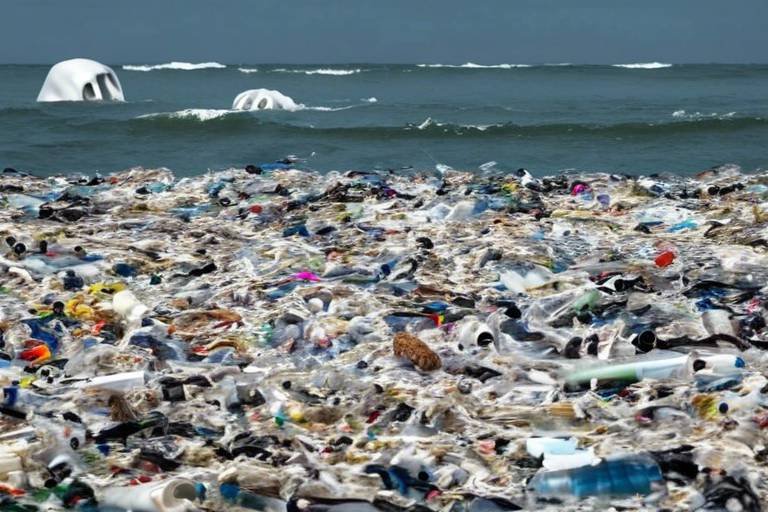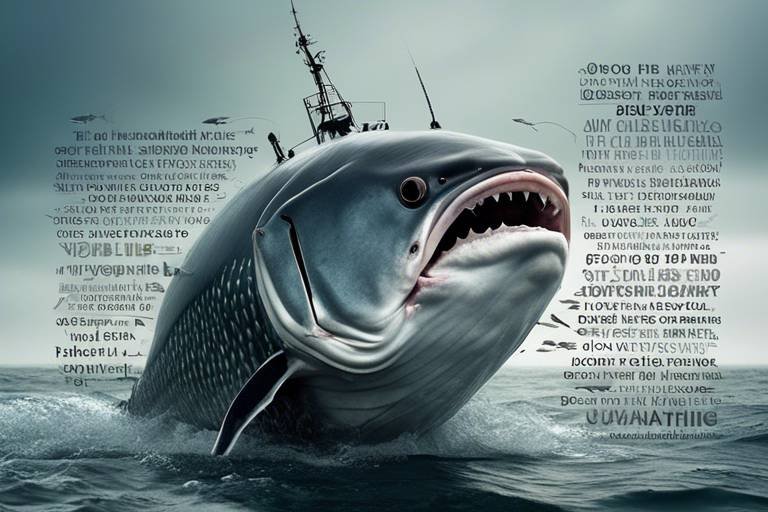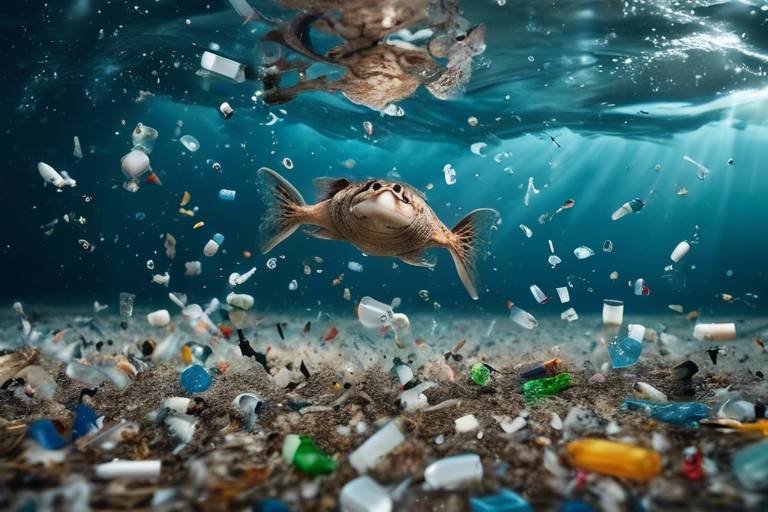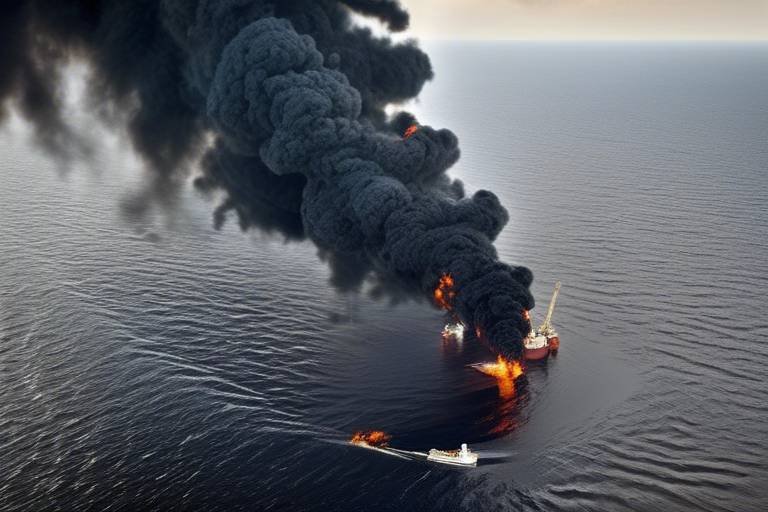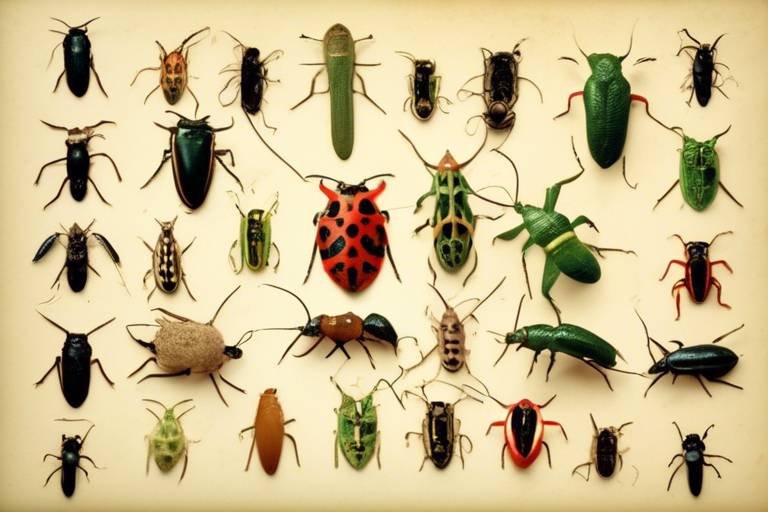Impact of Climate Change on Polar Wildlife
The phenomenon of climate change is not just a distant concern; it's a reality that is profoundly reshaping the delicate ecosystems of our planet, particularly in the polar regions. As temperatures rise and ice melts, the very fabric of life for polar wildlife is being threatened. Imagine a world where the majestic polar bear, a symbol of strength and resilience, finds itself struggling to survive due to the loss of its habitat. This isn't just a story of one species; it's a cascading effect that ripples through the entire ecosystem, affecting everything from the smallest microorganisms to the largest mammals. The urgency of the situation cannot be overstated, as the impacts of climate change are not only altering habitats but also challenging the survival of countless species that call these icy realms home.
Polar wildlife is uniquely adapted to thrive in extreme conditions. However, with the rapid changes in their environment, these adaptations may no longer suffice. For instance, the polar bear relies heavily on sea ice as a platform for hunting seals, their primary food source. As the ice diminishes, bears are forced to swim longer distances, leading to exhaustion and reduced hunting success. Similarly, seals depend on stable ice for breeding and resting. The loss of their breeding grounds spells disaster not just for them but for the entire food web that relies on these predators and their prey. It's a stark reminder that every action has a reaction, and in the case of climate change, the consequences are dire.
Furthermore, the implications of climate change extend beyond mere survival; they threaten the rich biodiversity of polar ecosystems. The intricate balance of life in these regions is under siege, as changing temperatures and melting ice disrupt traditional breeding and feeding patterns. This disruption can lead to food chain imbalances, where the decline of one species can result in a domino effect that impacts numerous others. For example, the decline of krill populations, which are vital for many marine animals, can have catastrophic effects on species ranging from fish to whales. The interconnectedness of life in polar regions is a testament to the fragility of these ecosystems, and the potential for widespread devastation looms large.
As we delve deeper into the challenges faced by polar wildlife, it becomes evident that the situation is not just about individual species but about the health of the entire planet. The melting ice caps and shifting climates are not isolated phenomena; they are indicators of a larger crisis that requires immediate action. The question we must ask ourselves is: what can we do to help? Understanding the urgency of the situation is the first step toward making a difference. Through conservation efforts and global collaboration, there is hope for the future of polar wildlife. We must act now to ensure that future generations can witness the awe-inspiring beauty of these remarkable creatures in their natural habitats.
- What are the main threats to polar wildlife due to climate change? The main threats include habitat loss, altered food availability, and disrupted migration patterns.
- How does melting ice affect marine life? Melting ice impacts marine ecosystems by altering habitats and food sources, affecting fish populations and other marine species.
- What can be done to protect polar wildlife? Conservation efforts, community involvement, and international collaboration are critical to protecting polar wildlife and their habitats.

Species at Risk
As we dive into the icy realms of our planet, it becomes painfully clear that many polar species are teetering on the brink of extinction due to the relentless grip of climate change. Imagine a world where the majestic polar bear, often dubbed the "king of the Arctic," struggles to find its footing on thinning ice. These magnificent creatures rely on sea ice as their primary hunting ground, and with temperatures soaring, their habitat is rapidly disappearing. The plight of the polar bear is just one example of the broader crisis facing wildlife in these frigid regions.
In addition to polar bears, other species like seals, walruses, and various migratory birds are also facing dire consequences. The loss of ice affects their breeding and resting spots, leading to decreased populations. For instance, the ringed seal, crucial for the survival of polar bears, uses sea ice to create nurseries for their pups. Without stable ice, these seals are left vulnerable, and the ripple effects on the food chain can be catastrophic.
To illustrate the gravity of the situation, consider the following table, which outlines some of the most vulnerable species and the specific threats they encounter:
| Species | Threats | Conservation Status |
|---|---|---|
| Polar Bear | Loss of sea ice, reduced prey availability | Vulnerable |
| Ringed Seal | Habitat loss, increased predation | Threatened |
| Walrus | Melting ice, hunting pressures | Near Threatened |
| Snowy Owl | Changing prey availability, habitat changes | Least Concern |
Each of these species plays a vital role in their ecosystems, and their decline signals a troubling trend for biodiversity. The interdependence of these animals means that the loss of one species can lead to a cascade of negative effects throughout the entire ecosystem. For instance, as the population of seals dwindles, polar bears face increased starvation, which in turn affects their ability to reproduce and sustain future generations.
So, what can we do to help? Awareness is the first step. By understanding the challenges these species face, we can advocate for stronger conservation policies and support organizations dedicated to protecting polar wildlife. Every small action counts, whether it’s reducing our carbon footprint or supporting sustainable seafood initiatives. Together, we can work towards a future where polar species can thrive once more.

Habitat Loss
As the planet warms, polar habitats are facing an unprecedented crisis, and the effects are nothing short of alarming. The polar regions, often seen as the last untouched frontiers of our Earth, are rapidly deteriorating due to climate change. This deterioration is not just a minor inconvenience; it’s a full-blown emergency that threatens the very survival of countless species. Imagine walking into a once-frozen landscape, only to find it transformed into a slushy wasteland. This is the reality for many polar animals, as their homes are melting away beneath their paws and fins.
The impact of melting ice is particularly profound. Ice caps serve as crucial habitats for various species, including seals and polar bears, who rely on stable ice for hunting and breeding. With the ice melting at alarming rates, these animals are forced to venture further and further in search of food and shelter. The loss of ice not only affects their immediate living conditions but also disrupts the delicate balance of the entire ecosystem. When you think about it, it’s like pulling the rug out from under a house of cards; everything starts to collapse.
Melting ice caps are a significant concern for polar wildlife. The Arctic and Antarctic regions are experiencing some of the fastest warming on the planet, resulting in a dramatic reduction of ice cover. According to recent studies, Arctic sea ice has declined by over 40% since the late 1970s. This not only reduces the habitat available for species like the polar bear but also affects their ability to hunt seals, which are their primary food source. The loss of these ice platforms means that polar bears have to swim longer distances, leading to exhaustion and decreased survival rates.
But the repercussions extend beyond the land. Melting ice caps also have a cascading effect on marine ecosystems. As ice melts, it alters the salinity and temperature of the surrounding waters, which can have dire consequences for fish populations and other marine species. For instance, species like krill, which are vital to the food chain, rely on stable ice conditions for their reproduction. Without ice, their numbers dwindle, leading to a ripple effect that impacts everything from seals to whales. It’s a classic case of how interconnected our ecosystems are; when one element falters, the entire system feels the strain.
Climate change doesn't just disrupt habitats; it also alters the migration patterns of polar wildlife. Many species, such as migratory birds and caribou, have specific routes they follow based on seasonal changes. However, as temperatures rise and ice melts, these animals are forced to adapt to new conditions. Imagine trying to find your way home in a city that’s constantly changing; that’s what these animals face every year. The shifting seasons and unpredictable weather patterns make it increasingly difficult for them to find food and mates, leading to declines in populations.
In summary, the loss of habitat in polar regions is a multifaceted issue that encompasses melting ice caps, impacts on marine life, and altered migration patterns. As we continue to grapple with the realities of climate change, it becomes increasingly clear that urgent action is needed to protect these fragile ecosystems. If we don’t act now, we may witness the extinction of some of the most iconic species on our planet, forever altering the biodiversity that has thrived in these regions for millennia.
- What are the main causes of habitat loss in polar regions?
The primary causes include climate change, melting ice caps, and rising sea levels. - How does habitat loss affect polar wildlife?
Habitat loss leads to decreased food availability, disrupted breeding grounds, and altered migration patterns for various species. - What can be done to mitigate habitat loss?
Conservation efforts, international cooperation, and community involvement are crucial in addressing habitat loss in polar regions.

Melting Ice Caps
The melting of ice caps is not just a statistic; it’s a reality that profoundly affects polar wildlife. Imagine a vast, white landscape slowly giving way to blue waters and barren ground. This transformation is happening at an alarming rate, and the consequences are dire. For species like the polar bear, whose very existence hinges on the presence of ice for hunting seals, the loss of ice caps means a significant reduction in their hunting grounds. Without sufficient ice, these majestic creatures are left struggling to find food, which can lead to malnutrition and, ultimately, a decline in their population.
As the ice melts, it doesn’t just impact the bears; it creates a ripple effect throughout the ecosystem. Many marine animals, including seals, rely on stable ice platforms for breeding and resting. When these platforms disappear, the seals are forced to adapt to new conditions, which may not be conducive to their survival. The melting ice caps also alter the salinity and temperature of the surrounding waters, which can disrupt the delicate balance of marine life. Fish populations, crucial for the survival of both seals and polar bears, may decline as a result, leading to a food shortage that can jeopardize entire species.
Furthermore, the melting of ice caps contributes to rising sea levels, which can lead to coastal erosion and habitat loss for various species. As the land erodes, the habitats of many birds and terrestrial mammals are threatened, pushing them further into competition for dwindling resources. The interconnectedness of these ecosystems shows that the loss of ice is not just an issue for the polar regions; it has implications for biodiversity on a global scale.
To illustrate the extent of this issue, consider the following table that summarizes the key impacts of melting ice caps on polar wildlife:
| Impact | Species Affected | Consequences |
|---|---|---|
| Loss of Hunting Grounds | Polar Bears | Malnutrition, population decline |
| Disruption of Breeding Platforms | Seals | Decreased reproduction rates |
| Altered Marine Ecosystems | Fish Species | Food shortages for predators |
| Coastal Erosion | Various Terrestrial Species | Loss of habitat, increased competition |
In summary, the melting ice caps are a harbinger of change that threatens the very fabric of polar ecosystems. The implications of this phenomenon extend far beyond the immediate loss of ice; they touch upon the survival of species, the health of marine environments, and the intricate web of life that connects them all. As we witness these changes, it becomes increasingly clear that urgent action is needed to mitigate the effects of climate change and protect the wildlife that calls these fragile regions home.

Impact on Marine Life
The consequences of climate change extend far beyond the terrestrial realm, significantly impacting marine life in polar regions. As the ice caps melt, the delicate balance of marine ecosystems is disrupted, leading to a cascade of effects that ripple through the food chain. The melting ice serves as a crucial habitat for numerous species, and its disappearance threatens the very foundation of life in these frigid waters. Have you ever considered how the loss of ice might affect a simple fish? It’s a complex web of interactions that begins with the ice and extends to apex predators.
One of the most immediate impacts of melting ice is the alteration of habitats for marine species. For instance, seals, which rely on ice for resting and breeding, find themselves in a precarious position. With fewer ice platforms available, their ability to reproduce and rear their young is compromised. This decline in seal populations has a direct impact on polar bears, which depend on seals as a primary food source. As the seals struggle, so do the bears, leading to a stark reality: less food for these majestic creatures means they face starvation and declining populations.
Moreover, the melting ice affects the nutrient flow in the ocean. Ice acts as a barrier that helps maintain colder water temperatures, which are essential for many marine species. As the ice retreats, warmer waters move in, altering the habitats that fish and other marine organisms depend on. For example, species like Arctic cod are sensitive to temperature changes, and their decline can have severe repercussions for the entire marine ecosystem. When these foundational species are affected, it sets off a chain reaction that can disrupt the entire food web.
Additionally, the melting ice caps lead to changes in ocean salinity and currents, further complicating the lives of marine animals. These changes can affect breeding grounds and migration patterns, making it harder for fish and other marine species to thrive. For instance, whales that migrate through these waters may find their traditional routes blocked or altered, leading to increased competition for food and breeding grounds. The effects are not just local; they can influence global fish stocks, affecting communities that rely on fishing for their livelihoods.
In summary, the impact of climate change on marine life in polar regions is profound and multifaceted. From habitat loss to changes in food availability and altered migration patterns, the consequences are dire. As we continue to witness the rapid changes in our climate, it becomes increasingly vital to understand and address these issues to protect the fragile marine ecosystems that play a crucial role in our planet's health.
- What are the main threats to marine life due to climate change?
Melting ice, rising temperatures, and altered ocean currents are the primary threats affecting marine ecosystems in polar regions. - How does the melting ice impact the food chain?
The loss of ice reduces habitats for seals and other marine animals, leading to a decline in their populations and affecting predators like polar bears. - What can be done to mitigate these impacts?
Conservation efforts, international cooperation, and sustainable practices are essential to protect marine life and their habitats.

Altered Migration Patterns
The impact of climate change on polar wildlife is not just a story of melting ice and rising temperatures; it also significantly alters the migration patterns of many species. Imagine a world where animals that have migrated for centuries suddenly find their routes blocked or their destinations uninhabitable. This is the reality for polar wildlife today. As the climate warms, the traditional cues that these animals rely on for migration—like temperature changes and food availability—are becoming increasingly unreliable.
One of the most striking examples of altered migration patterns can be seen in the behavior of caribou. These majestic creatures have long traveled vast distances in search of food and breeding grounds. However, as the tundra warms and vegetation shifts, caribou are finding it more challenging to locate their traditional grazing areas. This disruption not only affects their health but also impacts the predators that rely on them for sustenance, creating a ripple effect throughout the ecosystem.
Moreover, polar bears, which are often considered the poster species for climate change, are also feeling the impact of shifting migration patterns. As the ice melts earlier in the spring and freezes later in the fall, these bears are forced to adapt their hunting strategies. They depend on sea ice to catch seals, their primary food source, and with the ice retreating, they must swim longer distances to find food. This not only increases their energy expenditure but also puts them at greater risk of drowning, leading to a decline in their population.
In addition, seabirds that migrate to polar regions for breeding are experiencing similar challenges. Changes in the timing of ice melt and the availability of food sources can throw off their breeding cycles. For instance, if the ice melts too early, the fish that these birds rely on may not be present, leading to decreased reproductive success. The result? Fewer chicks survive to adulthood, further threatening the stability of these bird populations.
As we observe these changes, it becomes evident that the are not just a concern for individual species but for the entire polar ecosystem. The interconnectedness of life in these regions means that when one species is affected, it can have a cascading effect on others. For instance, if caribou populations decline, predators like wolves and bears may struggle to find enough food, leading to their decline as well.
In conclusion, the challenges posed by climate change are reshaping the landscapes and life cycles of polar wildlife. As migration patterns shift, the delicate balance of these ecosystems is at risk. It is imperative that we understand these changes and work toward solutions that will help preserve not just the animals themselves, but the intricate web of life they are a part of.
- How does climate change affect polar bear migration?
Climate change leads to melting ice, which is crucial for polar bears' hunting and breeding. As ice conditions change, polar bears may have to swim longer distances to find food, putting their survival at risk. - What species are most affected by altered migration patterns?
Species like caribou, polar bears, and seabirds are significantly impacted. Changes in food availability and habitat conditions disrupt their traditional migration routes and breeding cycles. - Can conservation efforts help mitigate these changes?
Yes, conservation strategies that involve local communities and international cooperation can help address the challenges posed by climate change and protect vulnerable species.

Food Chain Disruptions
Climate change is not just a buzzword; it’s a reality that’s shaking up the very foundations of polar ecosystems. Imagine a tightly woven tapestry, where each thread represents a species, all interconnected and reliant on one another. Now, picture that tapestry being pulled apart thread by thread — that’s what’s happening to the food chains in polar regions. As temperatures rise and habitats change, the delicate balance that sustains wildlife is thrown into disarray. This disruption can lead to a domino effect, where the decline of one species ripples through the entire ecosystem.
One of the most significant impacts of climate change on food chains is the alteration of prey availability. For instance, as ice melts, species such as krill, which are crucial for many marine animals, find their habitats changing. Krill thrive in icy waters, and with the reduction of sea ice, their populations are likely to dwindle. This decline affects larger predators, including seals and whales, who rely on krill as a primary food source. Without sufficient krill, these predators may struggle to find food, leading to malnutrition and decreased reproductive success.
Another critical aspect of food chain disruption is the changing distribution of species. As the climate warms, certain species may migrate to cooler areas, seeking refuge from rising temperatures. This shift can lead to competition between native species and newcomers. For example, fish species that were once confined to warmer waters may move into polar regions, creating competition for food with local fish populations. This competition can further strain the already vulnerable predator-prey dynamics, potentially leading to the decline of native species.
The effects of these disruptions are not limited to marine life. On land, polar bears, which are often seen as the poster species for climate change, face similar challenges. As their primary prey, seals, become less accessible due to changing ice patterns, polar bears may be forced to travel greater distances to hunt, expending more energy and ultimately jeopardizing their survival. The struggle for food becomes a desperate race against time, and without adequate nutrition, their populations are at risk of decline.
To illustrate the interconnectedness of these species, consider the following table that highlights key predator-prey relationships in polar ecosystems:
| Predator | Prey | Impact of Climate Change |
|---|---|---|
| Polar Bear | Seals | Reduced hunting grounds due to melting ice |
| Seals | Krill | Decline in krill populations due to habitat loss |
| Walrus | Clams | Changing sea temperatures affect clam distribution |
| Whales | Fish | Competition with new fish species entering polar waters |
As we can see, the repercussions of climate change extend far beyond individual species; they threaten the very fabric of the entire ecosystem. The loss of biodiversity due to food chain disruptions can lead to less resilient ecosystems, making them more susceptible to further environmental changes. It’s a stark reminder that every species, no matter how small, plays a vital role in maintaining the health of our planet. The question we must ask ourselves is: what can we do to help mitigate these changes and protect our polar wildlife?
- What is the main cause of climate change affecting polar wildlife?
Climate change is primarily driven by human activities, particularly the burning of fossil fuels, which increases greenhouse gas emissions and leads to global warming. - How does melting ice impact polar bear populations?
Melting ice reduces the hunting grounds for polar bears, making it harder for them to find food, which can lead to malnutrition and lower reproductive rates. - What role do local communities play in conservation efforts?
Local communities often possess invaluable indigenous knowledge about the land and wildlife, which can enhance conservation strategies and promote sustainable practices. - Are there any international agreements in place to protect polar ecosystems?
Yes, various international agreements, such as the Paris Agreement, aim to address climate change and its impacts on biodiversity and ecosystems.

Conservation Efforts
As the impacts of climate change become increasingly evident, the need for robust has never been more urgent. Various initiatives are being implemented worldwide to protect the vulnerable wildlife of polar regions and their fragile ecosystems. These efforts are not just about saving individual species; they are about preserving the intricate web of life that sustains them. The challenges are daunting, but the collective will of communities, governments, and organizations can make a significant difference.
One of the most effective strategies in conservation is the establishment of protected areas. These regions are designated to safeguard habitats and provide a refuge for wildlife. For instance, the creation of marine protected areas (MPAs) is crucial for conserving the delicate balance of marine ecosystems that are heavily impacted by melting ice. MPAs help to regulate fishing, reduce pollution, and allow marine species to thrive without the pressures of human activity. The success of these areas often hinges on effective management and enforcement, which require both local and international cooperation.
Moreover, local communities are key players in conservation. Indigenous knowledge and practices can significantly enhance the effectiveness of conservation strategies. For example, many indigenous groups have a deep understanding of their local ecosystems and can offer invaluable insights into sustainable practices that have been honed over generations. By involving these communities in decision-making processes, conservation efforts can be more culturally sensitive and effective. This collaboration leads to a shared sense of responsibility and stewardship over the land and wildlife.
International collaboration is also essential in addressing the global nature of climate change. Agreements such as the Paris Agreement aim to unite countries in the fight against climate change, recognizing that its impacts cross national borders. Through international partnerships, resources can be pooled, and strategies can be shared. For instance, the Arctic Council, which includes eight Arctic nations, fosters cooperation on environmental protection and sustainable development in the Arctic region. This collaborative approach can lead to more comprehensive and effective conservation measures.
In addition to these efforts, public awareness campaigns play a crucial role in conservation. Educating the public about the plight of polar wildlife can inspire action and support for conservation initiatives. Whether it's through social media, documentaries, or community events, raising awareness can mobilize individuals to contribute to conservation efforts. Simple actions, such as reducing carbon footprints or supporting sustainable products, can collectively lead to significant positive change.
In conclusion, while the challenges posed by climate change are formidable, the combined efforts of local communities, international collaborations, and public awareness campaigns create a pathway toward a more sustainable future for polar wildlife. By working together, we can ensure that these magnificent species and their habitats are preserved for generations to come.
- What are some examples of conservation efforts in polar regions?
Conservation efforts include the establishment of marine protected areas, community involvement in wildlife management, and international agreements aimed at reducing climate change impacts.
- How can local communities contribute to conservation?
Local communities can share traditional ecological knowledge, participate in conservation planning, and engage in sustainable practices that protect wildlife and habitats.
- Why is international cooperation important for polar conservation?
Climate change and its effects do not respect national boundaries; international cooperation allows for a unified approach to tackling these global challenges and sharing resources.

Community Involvement
When it comes to tackling the challenges posed by climate change, local communities are often the unsung heroes. These groups, especially those living in polar regions, possess a wealth of knowledge and experience that can significantly enhance conservation efforts. Imagine a treasure trove of wisdom passed down through generations, where every story and tradition holds a key to understanding the intricate balance of the ecosystem. This indigenous knowledge is invaluable, as it provides insights into animal behavior, seasonal changes, and sustainable practices that have been honed over centuries.
Moreover, community involvement fosters a sense of ownership and responsibility towards the environment. When locals are engaged in conservation efforts, they are more likely to protect their natural habitats. For instance, many indigenous communities have initiated programs that not only aim to conserve wildlife but also ensure that their cultural practices are preserved. This dual approach not only protects biodiversity but also strengthens community identity. It's like planting two seeds in one hole; you get to nourish the land while also nurturing the roots of your heritage.
One notable example of community involvement is the collaboration between scientists and local hunters in the Arctic. By working together, they gather crucial data on wildlife populations and migration patterns. This partnership not only enhances scientific research but also empowers local communities to play a pivotal role in decision-making processes. They are not just passive observers; they are active participants in shaping the future of their environment.
In addition to traditional knowledge, community-led initiatives often include educational programs aimed at raising awareness about the impacts of climate change. Workshops, community meetings, and outreach programs can effectively spread the message about conservation, ensuring that everyone understands their role in protecting polar wildlife. These initiatives serve as a rallying point, uniting individuals around a common goal. After all, when communities come together, they can create a powerful force for change, much like a flock of birds that move in perfect harmony to navigate through the skies.
Furthermore, community involvement can also lead to innovative solutions to combat climate change. Local groups often experiment with sustainable practices that can be scaled up or adapted to other regions. For example, eco-tourism initiatives can provide alternative income sources while promoting conservation efforts. This not only benefits the environment but also enhances the economic resilience of local communities. It's a win-win situation where conservation and livelihood go hand in hand.
In conclusion, the role of local communities in polar conservation cannot be overstated. Their unique perspectives, traditional knowledge, and active participation are crucial for developing effective strategies to combat climate change. As we move forward, it is essential to prioritize these collaborations, ensuring that the voices of those most affected by climate change are heard and respected. By doing so, we can create a more sustainable future for both polar wildlife and the communities that depend on them.

International Collaboration
When it comes to tackling the monumental challenges posed by climate change on polar wildlife, is not just beneficial; it is essential. The polar regions, characterized by their unique ecosystems and biodiversity, do not adhere to national borders. Therefore, the effects of climate change in one area can reverberate across the globe, making it imperative for countries to work together. Various international agreements and partnerships have emerged, aimed at preserving these fragile ecosystems and the wildlife that inhabit them.
One of the key frameworks for international cooperation is the Paris Agreement, which sets out a global action plan to combat climate change and its impacts. Under this agreement, nations commit to reducing greenhouse gas emissions and enhancing their resilience to climate change. The significance of this is profound, as it encourages countries to not only focus on their national policies but also to consider their role in the global context. By working together, nations can share knowledge, resources, and strategies that can significantly benefit polar wildlife.
Another noteworthy initiative is the Arctic Council, which consists of eight Arctic states and six indigenous organizations. This council plays a crucial role in promoting cooperation, coordination, and interaction among the Arctic states, particularly in the areas of sustainable development and environmental protection. The council's working groups focus on various aspects of Arctic life, including biodiversity, climate change, and the conservation of marine and terrestrial ecosystems. Through these collaborative efforts, countries are better equipped to address the challenges faced by polar wildlife.
Moreover, the Convention on Biological Diversity (CBD) is another pivotal international treaty that emphasizes the importance of conserving biodiversity, including polar ecosystems. The CBD encourages member states to develop national strategies for the conservation and sustainable use of biological diversity. This includes protecting endangered species and their habitats, which is particularly crucial in polar regions where climate change threatens numerous species. By aligning their conservation efforts with the goals of the CBD, countries can enhance their collaborative actions and ensure that polar wildlife receives the attention it desperately needs.
In addition to formal agreements, grassroots movements and local communities have also played a significant role in fostering international collaboration. Indigenous peoples, who have lived in harmony with polar ecosystems for centuries, possess invaluable knowledge about sustainable practices and biodiversity. Their involvement in international discussions not only enriches the dialogue but also ensures that conservation strategies are culturally relevant and effective. By integrating indigenous perspectives into global conservation efforts, we can create a more holistic approach to protecting polar wildlife.
However, the path to effective international collaboration is not without its challenges. Differences in political agendas, economic priorities, and resource allocations can create hurdles that impede progress. To overcome these obstacles, it is vital for nations to prioritize open communication and mutual understanding. By fostering trust and transparency, countries can work more effectively together to address the pressing issues facing polar wildlife.
In conclusion, international collaboration is a cornerstone of successful conservation efforts in polar regions. Through agreements like the Paris Agreement and the Arctic Council, nations can unite to combat climate change and its impacts on wildlife. By valuing indigenous knowledge and fostering open communication, we can create a robust framework for protecting the unique biodiversity of the polar regions. The survival of polar wildlife depends on our ability to work together, and it is a challenge that we must embrace with urgency and commitment.
- Why is international collaboration important for polar wildlife?
International collaboration is crucial because polar ecosystems cross national borders, and climate change impacts are global in nature. Cooperation allows countries to share resources, knowledge, and strategies to effectively address these challenges. - What role do indigenous communities play in conservation efforts?
Indigenous communities possess traditional knowledge and practices that can enhance conservation strategies. Their involvement ensures that efforts are culturally relevant and sustainable, benefiting both wildlife and local populations. - How do international agreements like the Paris Agreement help polar wildlife?
Agreements like the Paris Agreement set global targets for reducing greenhouse gas emissions and enhancing resilience to climate change, which indirectly benefits polar wildlife by addressing the root causes of climate change.
Frequently Asked Questions
- What are the main threats to polar wildlife due to climate change?
Polar wildlife faces numerous threats from climate change, including habitat loss, melting ice caps, and altered food availability. As temperatures rise, ice habitats are disappearing, making it difficult for species like polar bears and seals to hunt and breed effectively. Additionally, changes in the ecosystem can disrupt the food chain, impacting both predators and prey.
- How does habitat loss affect polar species?
Habitat loss severely impacts polar species by reducing their living space and hunting grounds. For instance, as ice melts, polar bears lose their platforms for hunting seals, which are their primary food source. This not only threatens their survival but also affects the entire ecosystem as these species play crucial roles in maintaining balance.
- What role do local communities play in conservation efforts?
Local communities are vital in conservation efforts for polar wildlife. Indigenous knowledge and practices can provide valuable insights into sustainable management and protection of habitats. By involving these communities in conservation strategies, we can enhance the effectiveness of initiatives aimed at preserving biodiversity in polar regions.
- Are there any international agreements focused on polar wildlife conservation?
Yes, there are several international agreements aimed at conserving polar wildlife and their habitats. These agreements foster collaboration between countries to address climate change impacts, protect endangered species, and promote sustainable practices. Examples include the Arctic Council and various treaties focusing on biodiversity and wildlife protection.
- How does climate change disrupt migration patterns of polar animals?
Climate change disrupts migration patterns by altering seasonal cues and environmental conditions that animals rely on. For example, changing ice conditions can force species to adapt their migration routes or timings, which can lead to mismatches in food availability and breeding cycles, ultimately threatening their survival.
- What can individuals do to help protect polar wildlife?
Individuals can contribute to the protection of polar wildlife by supporting conservation organizations, reducing their carbon footprint, and raising awareness about climate change issues. Simple actions, like using less plastic, conserving energy, and advocating for policies that protect the environment, can make a significant difference in the fight against climate change.


